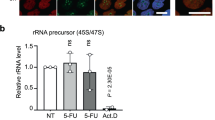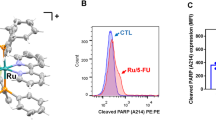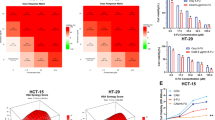Abstract
We have evaluated the RNA-directed cytotoxicity of 5-fluorouracil (5-FU) in human colonic carcinoma cells. The mode of action of 5-FU and its effects on human pre-rRNA processing were then examined. From these data, possible reasons why the disruption of pre-rRNA maturation could induce cytotoxic effects are considered. The results imply that inhibition of thymidylate synthase is not the sole primary cytotoxic lesion in this cell line. First, exogenous thymidine (dTHd) enchanced cytotoxicity. Second, addition of dThd to the cells was found to enhance incorporation of 5-FU into total cellular RNA. Third, 5-FU disrupted rRNA processing by a different mechanism from actinomycin D and methotrexate (MTX), suggesting that the inhibition was not just a consequence of cell death. Finally, the addition of dThd was found to enhance the disruption of rRNA processing consistent with an increase in concentration of 5-FU. These data are discussed in the light of literature reports and their potential for optimising 5-FU protocols.
This is a preview of subscription content, access via your institution
Access options
Subscribe to this journal
Receive 24 print issues and online access
$259.00 per year
only $10.79 per issue
Buy this article
- Purchase on SpringerLink
- Instant access to full article PDF
Prices may be subject to local taxes which are calculated during checkout
Similar content being viewed by others
Author information
Authors and Affiliations
Rights and permissions
About this article
Cite this article
Greenhalgh, D., Parish, J. Effect of 5-fluorouracil combination therapy on RNA processing in human colonic carcinoma cells. Br J Cancer 61, 415–419 (1990). https://doi.org/10.1038/bjc.1990.91
Issue date:
DOI: https://doi.org/10.1038/bjc.1990.91
This article is cited by
-
Downregulation of KRAB zinc finger proteins in 5-fluorouracil resistant colorectal cancer cells
BMC Cancer (2022)
-
Inhibiting eukaryotic ribosome biogenesis
BMC Biology (2019)
-
Non-coding rRNA-mediated preferential killing in cancer cells is enhanced by suppression of autophagy in non-transformed counterpart
Cell Death & Disease (2011)



